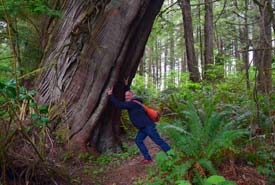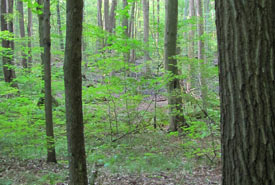Seeing the forest and the trees

Clayoquot Island Preserve, BC (Photo by NCC)
Canada is a forest nation. About 35 per cent (or roughly 3.48 million square kilometres) of the country is covered by forest. That’s an area larger than the size of India! In fact Canada’s forests are bigger than all but five of the world’s countries. It’s a lot of Canada, and also a lot of the world’s forests. Canadians steward about nine per cent of the all the world’s forests, but a whopping 25 per cent of the planet’s most intact forests.
A country of many forests
Our massive northern boreal forests are some of the largest and most pristine forests left on the planet. They are true wilderness, where ecosystems and species continue to function with minimal human influence.

Backus Woods Addition, Southern Norfolk Sand Plain, ON (Photo by NCC)
Our southern forests are very different. In some forest regions such as the Carolinian, much of the original forest cover has been lost. Other forest regions, including the Acadian, Great Lakes–St. Lawrence and montane, maintain high amounts of forest cover, but we have lost much of the original old-growth forests that were once dominated by large trees.
These forests are also becoming increasingly fragmented, creating new challenges for wildlife that need large, connected forests. In these southern forests, the Nature Conservancy of Canada (NCC) is working to conserve key sites that still harbour outstanding forest biodiversity, and to protect and restore wildlife corridors that connect our forests.
What is a forest anyway?
According to Natural Resources Canada, a forest is generally characterized by a dense and extensive tree cover. In some places, such as the northern treeline along the edge of Canada’s Prairie, and in drier regions, there is a wide transition zone between forest and open habitats, and trees are more widely spaced.
Fast facts
Disturbances shaping forest composition, structure, habitat diversity:
- fire
- insects
- disease
- drought
- storms
Climate change affects the frequency and intensity of these disturbances.
More on disturbances and deforestation >
Why forests matter to all Canadians
In addition to their biodiversity, forests are important for our well-being and economy. Forests supply important ecological services:
- forests help to control floods;
- forests purify our air and water;
- forests hold vast amounts of carbon.
Read more about the natural capital value of forest conservation >
In many large Canadian cities, such as Vancouver and Halifax, protected forested watersheds play an important role in safeguarding drinking water.
During National Forest Week, all Canadians should take pride in our forest nation and the trees that define and sustain us. Learn more about Canada’s forests in the infographic below!

(Inforgraphic by NCC, graphics from Piktochart)


